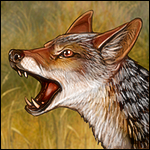|
|
|
|---|---|
| Posted by | Lioden Genetics Guide (revised 5/11/15) |
 Alma (#7695) 
King of the Jungle View Forum Posts  Posted on 2015-05-08 05:27:22 |
Lioden's new inheritance model is here, and because it's based on another model I proposed (the one you may have seen and voted on in a News post), I thought I'd create a game guide for it to help explain how it works. This new model focuses on four basic factors inherited from one or both parents: * Color Group: Black, Red, Cream, or Golden * Gradient: Countershaded vs Solid color * Shade/Range: Dark or Light * Rarity: Common or Special Unlike actual genetics, the only thing that matters is the visible color of each parent. Pedigree/heritage has no bearing on inheritance, and there are no recessive traits or "carriers": what you see is what you're working with. Here's what's at work in this model: The first factor is Color Group. In this model, a cub will inherit a Color Group from one of its parents. These are the 4 color groups in this model:  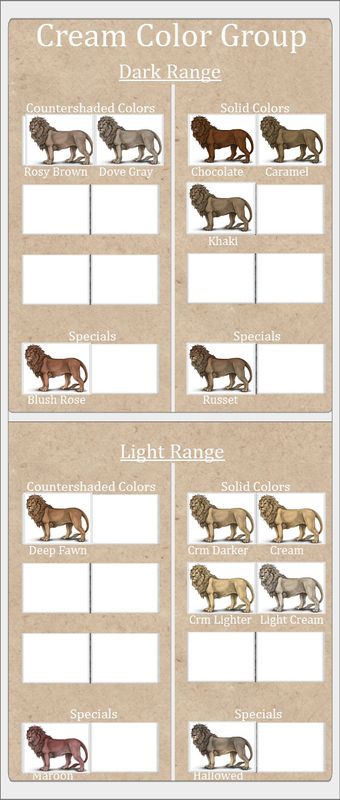  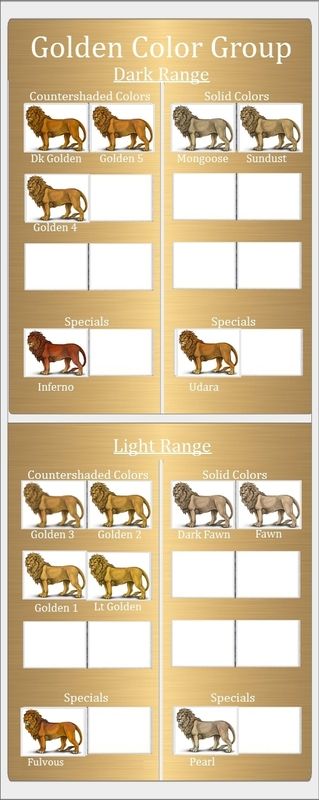 If I cross two parents from the Black Color Group, then ALL offspring will come from the Black Color Group. If I cross a parent from the Black Color Group and the Red Color Group, I could get offspring from either the Black or Red Color Groups. If you're looking to produce offspring of a specific color, it is wise to breed parents from the same Color Group if not the same color; if you're looking for surprises and a wide variety of colors, breed two parents from completely different Color Groups. The next factor in this model is Countershaded vs. Solid Colors, and a cub's appearance will be inherited just like its Color Group (from one parent only unless they're both the same). A Solid color looks exactly as it sounds: the base color is completely or nearly the same throughout the entire coat. A Countershaded color is a base color that has more than one color in its makeup, and while most colors countershade from a dark topline to a lighter underside, others are lighter at the topline and darker on the underside while the most recent is shaded darker along the midline. Here's some examples of what this looks like: 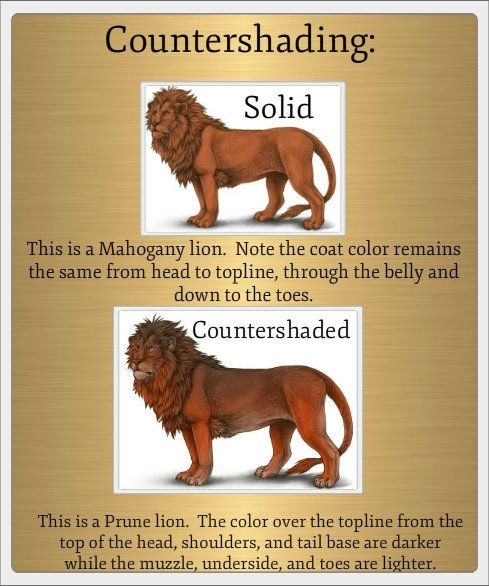 If both parents are Countershaded, then all cubs would be Countershaded; if both parents are Solid, then all cubs would be Solid, and if there is one parent of each type, then both Countershaded and Solid cub colors are possible. If I cross two Countershaded parents, then ALL offspring will be Countershaded, and two Solid parents beget Solid offspring. If I cross a Countershaded parent and a Solid parent, I could get Countershaded or Solid offspring. If you're looking to produce offspring of a specific color, it is wise to breed parents that match the same Shade as your target color if not the same color; if you're looking for surprises and a wide variety of colors, breed a Countershaded parent and a Solid parent, which will increase your variety DRAMATICALLY. The third factor in this model is Dark or Light Shade/Range. In this model, all colors within a Color Group are arranged into Dark and Light Shade/Ranges. The shade of the offspring is determined just like the other two factors: Dark Range Color X Dark Range Color = Dark Range Color Light Range Color X Light Range Color = Light Range Color Dark Range Color X Light Range Color = Dark OR Light Range Color I'll quote the original news post in regards to Rarity: "Rarity however is passed differently, and instead of simply being 50/50 between the mom or dad’s there’s only a 15% chance of a special cub per parent breeding. This means: If two specials breed, there is a 30% chance of a special cub. If one special breeds with a common, there is a 15% chance. If two commons breed, there is 0% chance. Furthermore, there are a few bases that require at least one parent to have the same base when breeding in order to be passed on. Those are: Celestial, Lilac, Sepia, Pearl, Blush Rose, Inferno and Hallowed. Those bases also have a lower drop rate than regular special bases." Albinos are somewhat different, as explained in Xy's update, "Albino genetics (are) still a random occurrence, but it has a chance of passing now if one parent is Albino, and that chance is higher if both are Albino." Sounds simple enough, right? Let's give ourselves a chance to get familiar with this system and put all these factors to work! Here are two example breedings: 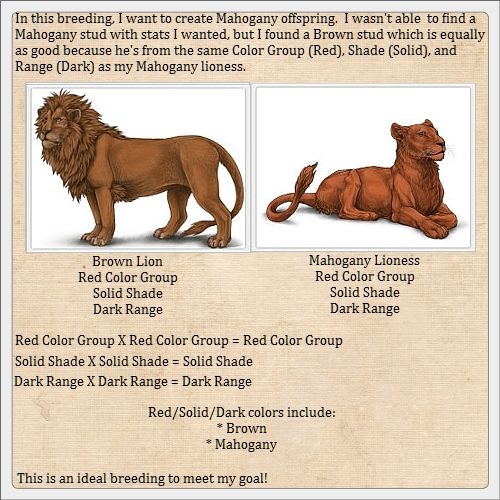 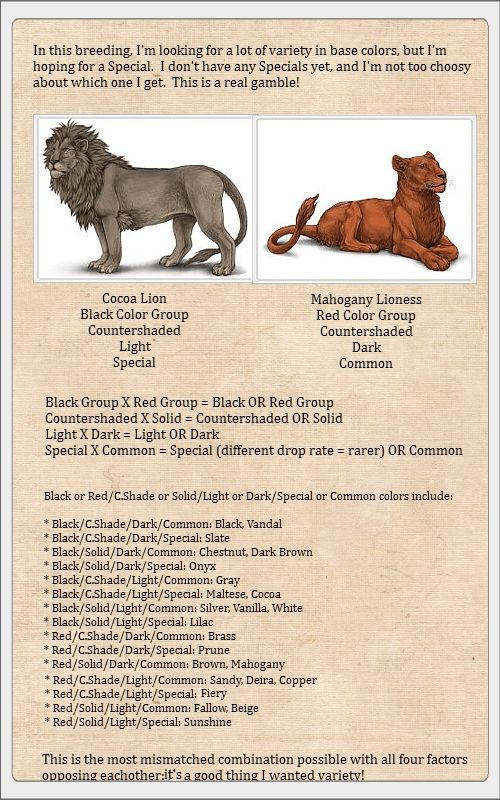 The second example shows how much variety a mismatched cross can give, so if you're looking for surprises, choosing wildly different parents will certainly give you that. On the other hand, if you're looking to breed a cub the same color as one of its parents, it pays to breed the desired parent to an individual of the same color or something from the same Color Group, Gradient, Shade/Range, AND Rarity. ... and that, fellow Lioden-ners (?!) is how Lioden inheritance works! I hope this guide has helped anyone with questions about the system to find the answers you were looking for, but if not, as I promised when I proposed my very first model 15 months ago, I will happily answer questions and help you find the best breeding to meet your goals here. Good luck and happy cub-making! For the next "installment" of my game guides, here's a how-to about breeding strategies: Successful Breeding for Specific Colors  3 players like this post! Like? 3 players like this post! Like? Edited on 11/05/15 by Alma (#7695) |
|
Valana {HM} (#44115)
View Forum Posts  Posted on 2015-05-11 17:00:11 |
Msasi Having the exact percentages would really be nice. That's another thing that annoys me with this system. Not only do I get terrible fail colours, but also worse drop rates than the normal specials and no idea what the exact numbers are..grrraahhh xDD Also wow, 300 tries for bith Sepia and Lilac, that's a lot of work, thank you so much for the data on those <3 Before Yeah, I also did some testing and I got 14 Sepias out of 100 Sepia x Sepia. So not sure if Sepia is more common than Lilac or if the numbers are allwrong, since 100 isn't much to go by. Anyway, thanks for your hard work, even if the numbers aren't perfect it's still interesting to see :)  0 players like this post! Like? 0 players like this post! Like? |
Xylax (#4)
 
Dreamboat of Ladies View Forum Posts  Posted on 2015-05-12 05:04:54 |
This is not the place to debate the changes. This is a guide thread. Keep these comments off of this thread, if you wish to critique anything, please take it to Dev Boards. I am removing the comments that derail the thread.  0 players like this post! Like? 0 players like this post! Like? |
|
Morr 🔥 9BOx2Mottx2RoS (#26583) View Forum Posts  Posted on 2015-05-12 12:04:35 |
Alma, if i bred a fiery and an onyx, id have 30% special rate, and a chance at: 30% Fiery or onyx, 35% chestnut and dark brown 35% sandy, deira, and copper Correct? Or is there anything i missed/confused?  0 players like this post! Like? 0 players like this post! Like? |
Alma (#7695)

King of the Jungle View Forum Posts  Posted on 2015-05-12 14:36:17 |
Actually, because the two of those are opposite in 3 of 4 factors, (differing Color Groups, Solid vs C.Shade, Light vs Dark), you would be able to get every color in the Black Color Group minus Celestial and Lilac and everything from the Red group minus Sepia (those are "Super Specials"). If you're targeting Fiery, the best match would be Fiery, but if you're looking for a "fails" other than Sandy, Deira, or Copper, Maltese and Cocoa will add Gray fails without giving you such a wide range. Both Fiery and Malt/Cocoa are C.Shaded/Light/Specials, so three out of four of the factors match: this is what I like to call a "one-off" breeding because only one of the factor doesn't match. It's a good strategy when you don't like the fails of the color group your Special is in, but you like the Special's color. If you're targeting Onyx and you'd like to add some red-based fails, Sepia's your best bet, as both Onyx and Sepia are Solid/Dark/Special (this is also a "one-off"). This pairing would result in Chestnut, Dk. Brown, Brown, and Mahogany as well as Onyx and Sepia. There's a link to my breeding guide at the bottom of the original post, and it might help explain this in greater detail!  0 players like this post! Like? 0 players like this post! Like? |
|
Msasi (#21461)
Special Snowflake View Forum Posts  Posted on 2015-05-12 14:36:48 |
Actually, you'd get a bunch! Pretty much the entire spectrum of the Black and Red groups! Onyx is Black Dark Solid Special while Fiery is Red Light Countershaded Special. Because one is Black and one is Red, you can get cubs from the Black and Red Groups. Because one is Dark and the other is Light, you can get both Dark and Light cubs. Because one is Solid and the other is Countershaded, you can get Solid and Countershaded cubs. So, from Onyx x Fiery, you can get: Chestnut, Dark Brown, Onyx, Black, Vandal, Slate, Silver, Vanilla, White, Gray, Cocoa and Maltese from the Black group. Brown, Mahogany, Brass, Prune, Beige, Fallow, Sunshine, Copper, Deira, Sandy, and Fiery from Red group. And Albino as a random chance. The only coats from those two groups you CAN'T get are Celestial, Lilac and Sepia, because those three require at least one parent of that base coat to produce cubs with the coat. (Sorry I didn't calculate out the possible percents; it's getting late and I need to be up at 4 am XD;). Edit: Ahaha. XD You beat me, Alma! Oh, but by less than a second. Now I don't feel so bad about not refreshing before posting. ;)  0 players like this post! Like? 0 players like this post! Like?Edited on 12/05/15 by Msasi (Fight Me!) (#21461) |
|
Morr 🔥 9BOx2Mottx2RoS (#26583) View Forum Posts  Posted on 2015-05-12 14:57:16 |
Dang, thank you both! XD Hmmm ok, i have plenty of cocoas and maltese in my den :) Thank you alma! Onyx would have been a nice side thing too, and i dont mind dark brown or chestnut so i figured those two would work well. I also kind of like those coats....ill try a few fiery/onyx breeds and then ill try fiery fiery, then fiery malt/cocoa :) thank you both!  0 players like this post! Like? 0 players like this post! Like? |
|
Snowcat13-G1 Ice-6 cimm (#52694) 
Dreamboat of Ladies View Forum Posts  Posted on 2015-05-15 22:50:51 |
Did albino change how it's inherited? I bred a celestial and a maltese and got an albino. Also a maroon and a maltese and got an albino. Neither of those should be possible using chart right?  0 players like this post! Like? 0 players like this post! Like? |
|
Meso (#49519)
Usual View Forum Posts  Posted on 2015-05-15 23:10:49 |
|
Snowcat13-G1 Ice-6 cimm (#52694) 
Dreamboat of Ladies View Forum Posts  Posted on 2015-05-16 01:42:38 |
Ok, thanks. So far with 1 or 2 lilac parents out of 30 cubs I have got one lilac. I was so surprised to actually see one I didn't recognize it at first. LOL I have a spreadsheet. :)  0 players like this post! Like? 0 players like this post! Like? |
|
Msasi (#21461)
Special Snowflake View Forum Posts  Posted on 2015-05-16 03:11:18 |
Sometimes you just get lucky! My first two Sepia x Sepia breedings under the new system have both given me a Sepia cub, so luck happens!  0 players like this post! Like? 0 players like this post! Like? |
|
Unicorn Fluff (#51743)
Impeccable View Forum Posts  Posted on 2015-06-07 07:13:21 |
|
Msasi (#21461)
Special Snowflake View Forum Posts  Posted on 2015-06-07 09:09:52 |
Pretty much! I think the only thing missing from the images is the Bone base (it's Golden Light Countershaded Common).  0 players like this post! Like? 0 players like this post! Like? |
Alma (#7695)

King of the Jungle View Forum Posts  Posted on 2015-06-09 14:56:47 |
Sorry I haven't gotten Bone added yet: I've been really busy in real life. If you don't see a base here because I don't have it added yet, it's usually found in the Genetics section of the Wiki (Kitty's is much nicer than mine). Thanks again, Msasi, for fielding these questions!  0 players like this post! Like? 0 players like this post! Like? |
|
HappyLion (#18888)
Dreamboat of Ladies View Forum Posts  Posted on 2015-06-14 17:29:04 |
Are eye color, mane type, and mane color just inherited from one parent? For example, will a green eyes x blue eyes pairing only produce offspring with green or blue eyes?  0 players like this post! Like? 0 players like this post! Like? |
Minimanta (#1684)
 
Usual View Forum Posts  Posted on 2015-06-14 18:57:31 |
I'm not sure about the rest, but rarer eye colors can fail to more common colors. Red eyes can give brown eyes, ice eyes can give blue eyes, hets can give either of the two eye colors and so on.  0 players like this post! Like? 0 players like this post! Like? |
Memory Used: 633.91 KB - Queries: 2 - Query Time: 0.00077 - Total Time: 0.00482s
 Report
Report


